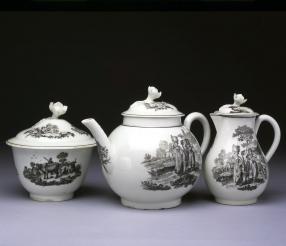Tea service, ca. 1770
|
|
The soft-paste porcelain tea service has a lead-based glaze that is essentially clear, but puddles a slightly yellow color where it is thicker.
It is composed of a coffeepot, teapot, tea caddy, waste bowl, lidded sugar bowl, lidded cream jug or creamer, oval tray, hexagonal tray, six teabowls, and one handled coffee cup.
The teapot is ball-shaped, on a low foot. It has a C-curved tubular handle and a tapered spout with a slight S-curve. The rim of the pot has a high, straight collar. The separate cover has a projecting straight edge, and a low dome with a flattened top, from which rises an open bud knop. The bottom of the cover has a short straight rim or flange that fits within the rim of the pot. There are two applied transfer motifs on the two sides of the pot, one side with a farmer/maiden/animals beneath a tree (the pattern known as "Rustic Lovers"); and one with "The Milkmaids." Small floral motifs ornament the cover and the spout.
The baluster-shaped creampot or cream jug stands on a low, straight foot, has a high, C-curved tubular handle and small spout opposite. The separate lid has a sharply projecting edge, and a low dome with a flattened center from which rises an open bud knop. On each side of the bulbous body is an applied transfer depicting dairymaids, a dairyman, and cattle. Cows munch grass in the background. Two small, rustic motifs ornament the cover.
The sugar bowl is in the form of a Chinese rice bowl: low, with a straight foot and high flared sides. The separate cover has a sharply projecting edge, a low double dome rising to an open bud knop with a leaf. The edge of the cover is outlined with a single black stripe, and ornamented by two applied transfer motifs.
The forms of the two trays mimic Chinese teaware forms: the hexagonal teapot stand and tapered spoon rest. In the center of each is an applied transfer motif of milkmaids and dairy farmers. According to Spero and Sandon (see Publications), "The milkmaids" is based on a 1766 engraving by Robert Sayer, and is "one of the three most common overglaze prints on First Period Worcester porcelain." Robert Hancock produced a well known version of the pattern; its popularity led other engravers to create versions as well.
Believed bought by Franklin for his wife or daughter; descended in his family |
|






